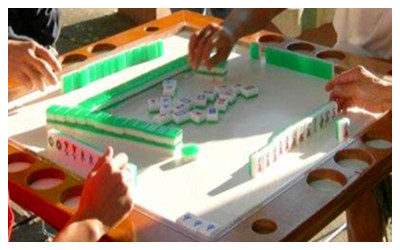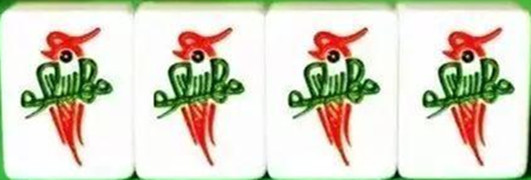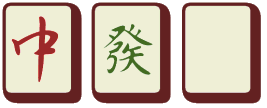Skype: neodalle-travel
Tel: +86 135 7447 2266
E-mail: sales@visitaroundchina.com

 Mahjong or Majiang (麻将) is a traditional Chinese game combining skill and chance broadly similar to the card game of rummy the aim is to collect related groups of tiles, however the set of tiles and rules are a lot more complex than for cards. Like Chinese chess it is often played in tea-houses and the clattering of tiles on tables is a frequently heard background sound. The tiles were originally made of bone, bamboo or ivory but now are made from plastic.
Mahjong or Majiang (麻将) is a traditional Chinese game combining skill and chance broadly similar to the card game of rummy the aim is to collect related groups of tiles, however the set of tiles and rules are a lot more complex than for cards. Like Chinese chess it is often played in tea-houses and the clattering of tiles on tables is a frequently heard background sound. The tiles were originally made of bone, bamboo or ivory but now are made from plastic.
The game usually has four players who take it in turns to pick up tiles to try to form sets. The first task is to shuffle the tiles, all players take part by moving them around with both hands, with the faces of the tiles downward. Then the wall is built. The square 牌墙 pái qiáng wall is 18 tiles wide and 2 tiles high in a square, face down. The dealer then throws three dice to determine where to start dealing out the tiles. The score determines which wall and part (quarter) of the wall start point. The dealer then takes four tiles from the left of this position and the other players take a set of four until they all have 12 tiles (3 sets of 4) moving clockwise around the wall. Each player then finally takes a single extra tile in turn to make a total of 13 tiles. A quicker version just takes the tiles from a corner of the dealer's portion of wall.
At this stage if any player has a ‘flower’ or ‘season’ tile these are set aside (used for scoring bonuses) and an extra tile is picked up to replace them.All players are associated with a compass direction. East - South - West - North. After each round the designation of 'dealer' or East wind moves around one place anti-clockwise. The game is complete when all four players have been dealer. Whenever the dealer wins a hand or if there is no winner (a draw) an extra hand is played.
The standard Mahjong set
Mahjong circles: 36 Circle tiles in 4 identical sets of 9 tiles with one to nine circles engraved on them. In Chinese they are 筒子 (tǒng zi) meaning ‘barrel’ or ‘tube shaped’, named after circular coins with a hole in them. The circles are also known as ‘tans’ or ‘dots’.

Bamboos
36 Bamboo tiles in 4 identical sets of 9 tiles with one to nine bamboo stems engraved on them. Bamboo in Chinese is 竹( zhú ) or else the 索子 (suǒ zǐ ) or ‘woven thread suit’. The '1' is usually a picture of a bird; often a sparrow 麻雀 má què by which the game is named in teh south. The bamboos are also known as ‘soks’ or ‘bams’.

Charactors
36 Number tiles in 4 identical sets of 9 tiles with the characters for the numbers 1 to 9 engraved on them. The character for 万 (wàn萬 10,000) or myriad is underneath each Chinese number. They are also known as ‘wans’ or ‘craks’. Old Chinese coins were often strung together in hundreds, a hundred of such strings represented a large number of coins - 10,000 and is often used to mean ‘countless’ or ‘beyond measure’.

Serials
The circles, bamboos and numbers form the 序数牌 (xù shù pái ) or the ‘serials’ and only these tiles can form runs or ‘chows’. The ones and nines at the ends of the sequence are called ‘terminals’ or 纯幺九 (chún yāo jiǔ). The terminals can contribute to high scoring hands.

Winds
There are 16 Wind tiles in 4 identical sets of 4 tiles for each of four wind directions (east, south, west and north) Collectively known as the 风牌 fēng pái they are always listed in this order: 东 南 西 北

Dragons
There are 12 Dragon tiles in 4 identical sets of 3 tiles: red; green and white dragons. Collectively they are also known as the 三元牌 sān yuán pái three scholars, the change to ‘dragons’ may be a result of the export to America. 红中 hóng zhōng (Traditional 紅中 ) Red dragon or Red center 青发 qīng fā (Traditional 青發 ) Green dragon or Green fortune 白板 bái bǎn Blank or White dragon or White board. The white dragon is often a blank tile but may be just a blank frame.

Honor tiles
The 12 dragons and 16 winds together are called 番子 fān zǐ ‘the Honor’ tiles.
History of Mahjong
According to the search, the oldest known sets of Mahjong come from about 1870 in the Ningbo region of Zhejiang, perhaps by Chen Yumen (1817-1878). On the other hand the mystique of an ancient game from the mysterious and exotic East was a major selling point, so it is possible it was invented more recently. Some people have said it goes back all the way to the time of Confucius but there is no evidence for this.
The names normally used for the tiles indicates the export to America came from the Guangdong (Canton) area. It was originally known as 麻雀 (máquè ) or sparrow game in English and is still known by that name in southern China; while in the north it is 麻将 (má jiàng). Mahjongg has been become a great craze as a parlor game since the 1920s. Chinese Mahjong is another famous Chinese invention and export to the rest of the world.
 Ask Questions ?
Ask Questions ?